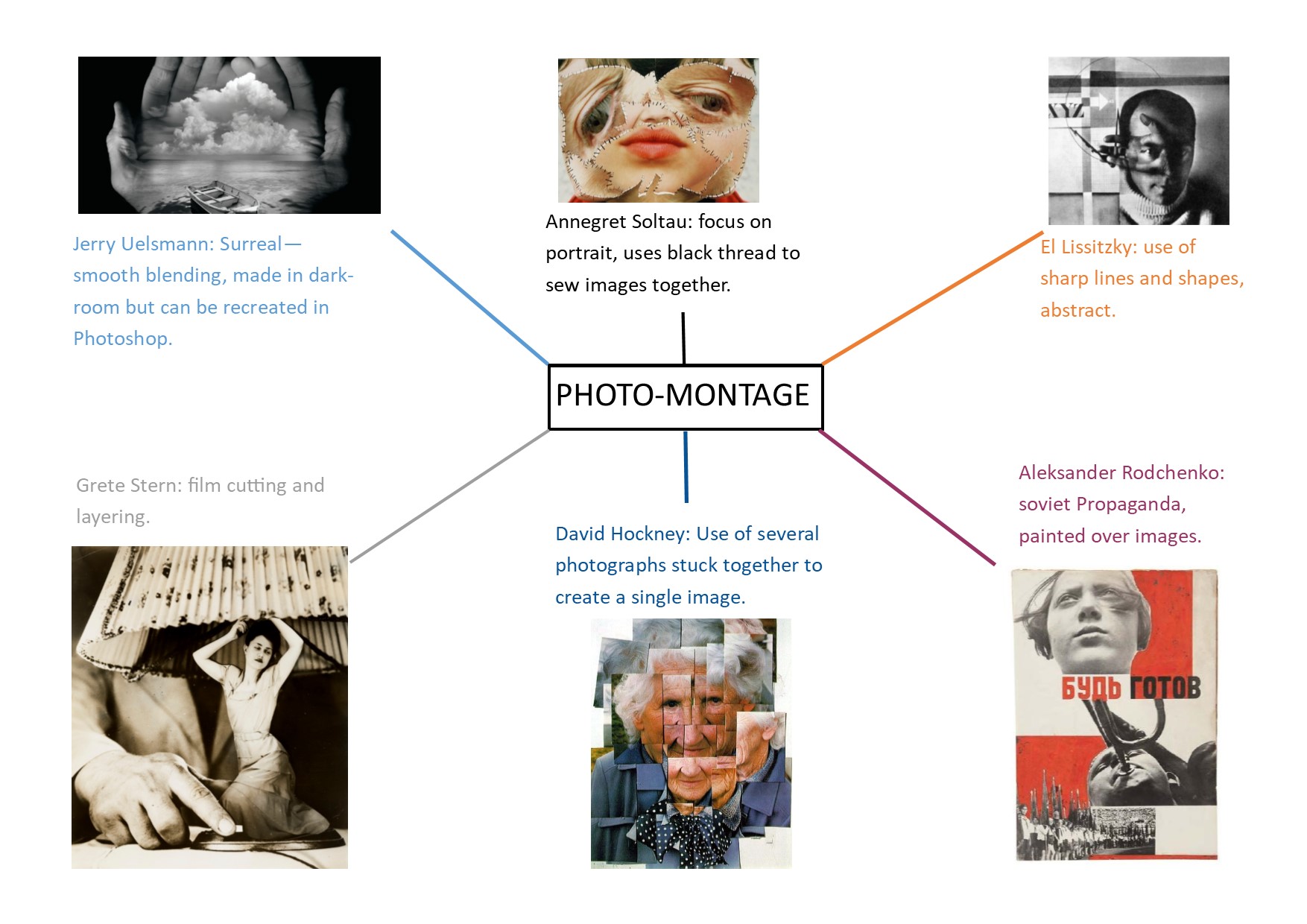
Examples of Early – 20th Century Photo Montage:

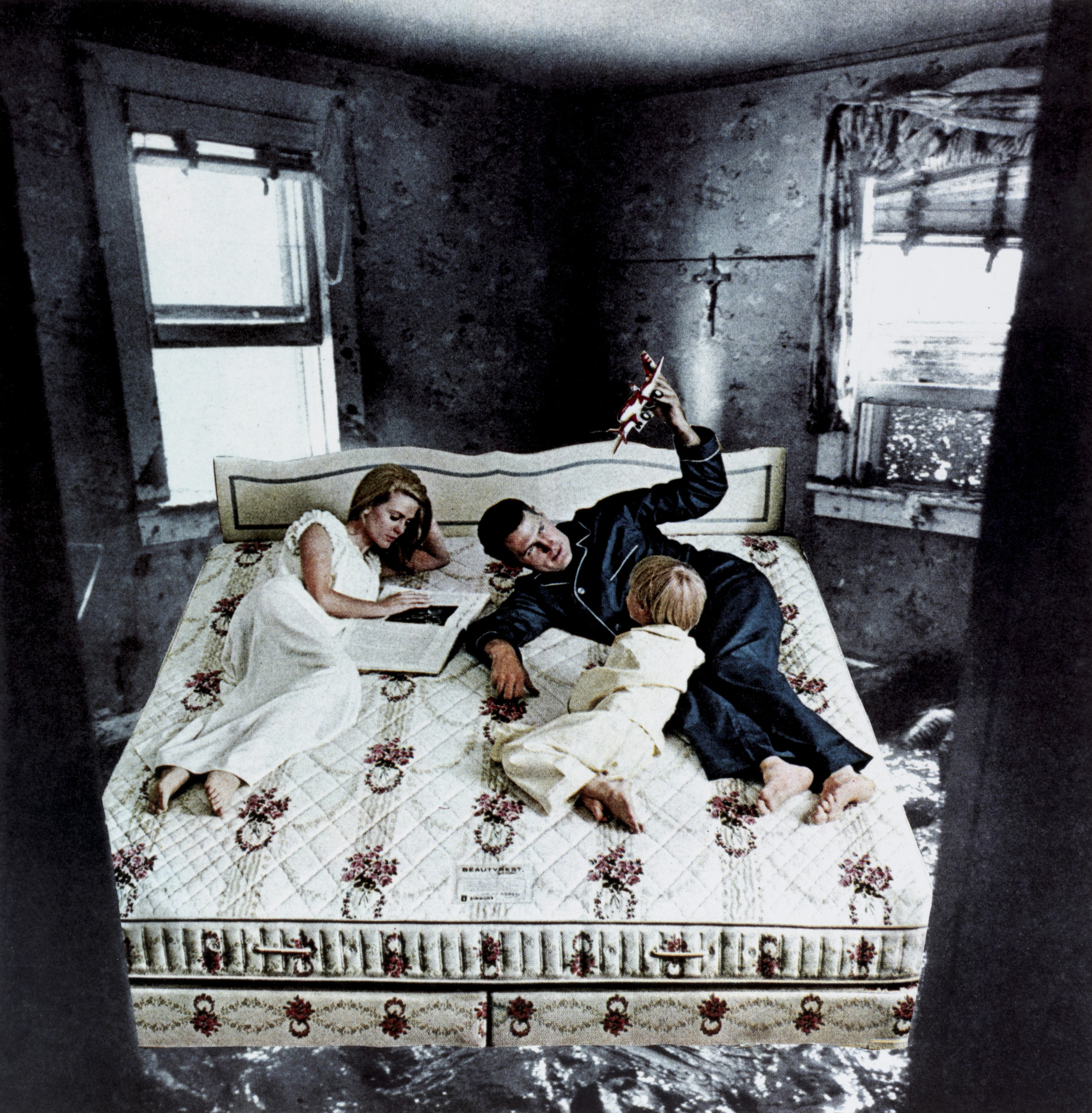











John Heartfield (born Helmut Herzfeld) was a German photographer best know for his work in photo-montage. Much of his most famous works were anti fascist/Nazi statements. He used the political nature of his photography as a form of visual art to use as a “political weapon”. John was a prominent figure in the style of photography known as dadaism.
Some of his photo-montage featured various pieces of artwork in conjunction with various photographs. the majority of his photography is borrowed however combines the photos/artwork into a powerful political statement.
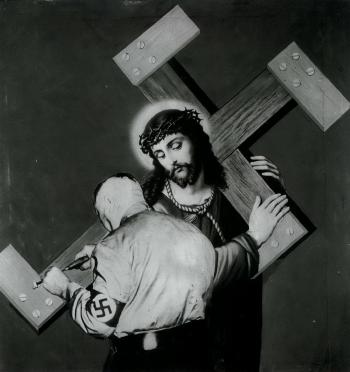
“The cross was not yet heavy enough”
This piece uses explicit religious imagery to convey the Nazi’s as an enemy of Christ.
Not much can be said for the technical aspects of John’s photography since much of the photographs used are borrowed however the photos are put together simply by cutting and pasting while occasionally painting/drawing directly onto the frames.
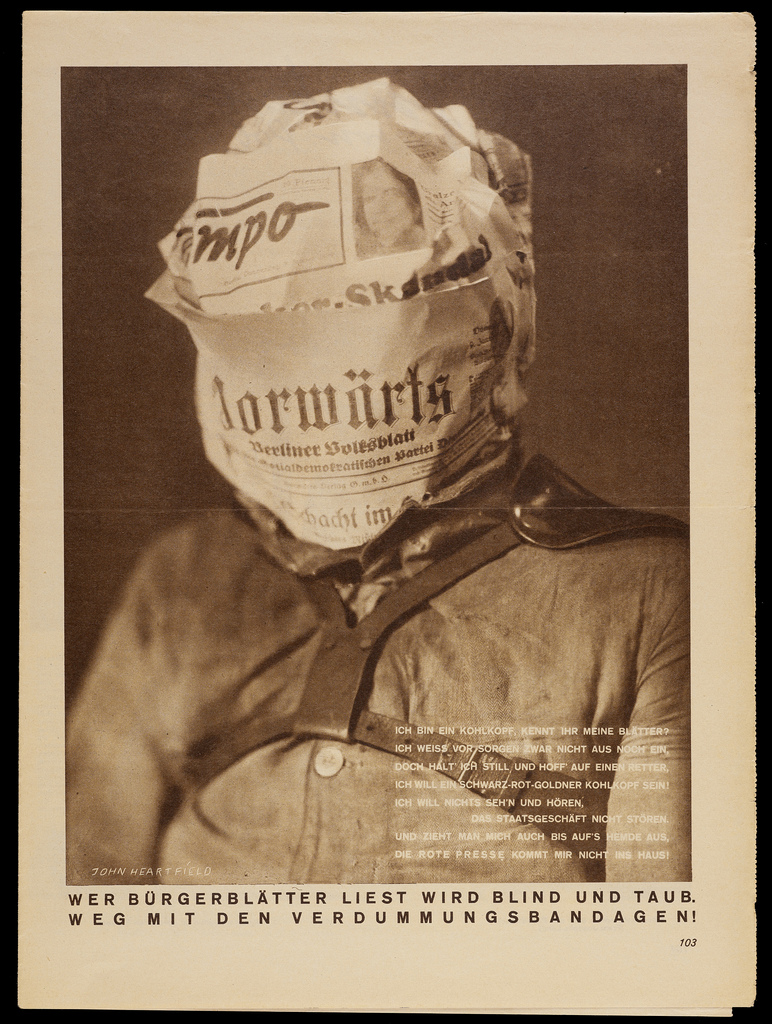
“Whoever Reads Bourgeois Newspapers Becomes Blind and Deaf: Away with These Stultifying Bandages!”
This piece is much different to the rest of John’s work as it doesn’t utilize traditional photo-montage and instead is a more traditional photo as this was a photo-shoot that was setup primarily for this shot and isn’t a combination of images. The photo is framed like many portraits taken of Nazi officials however it features a German newspaper wrapped around his head suggesting that the German people are so absorbed by the news that they are a slave to the media, this is also implied by the attire of the subject which suggests that they are being incarcerated. The photo is essentially telling the viewer that the Bourgeois news was heavily biased and will leave the reader with a closed mind.
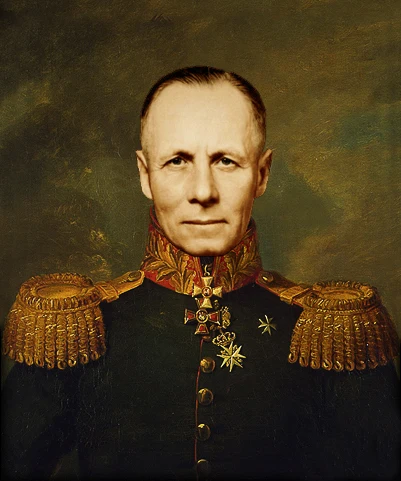

2 portraits of Erwin Rommel of similar composition to the piece by John
A Photo-Montage is a collage constructed from photographs.
In history photo-montage has often been used as a means of expressing a political agenda and used as propaganda. It was first used as a technique by the dadaists in 1915 in their protests against WW1. It was later adopted by the surrealists who exploited the possibilities photo-montage offered.
In 1923 the Russian constructivist Aleksander Rodchenko began experimenting with photo-montage as a way of creating striking socially engage imagery.
Other key components of the medium are John Heartfield, the German artist who reconstructed images from the media to protest against Germany’s Fascist regime and Peter Kennard, whose photo-montages explored issues such as economic inequality, police brutality and the nuclear arms race between the 1970’s and the 1990’s.

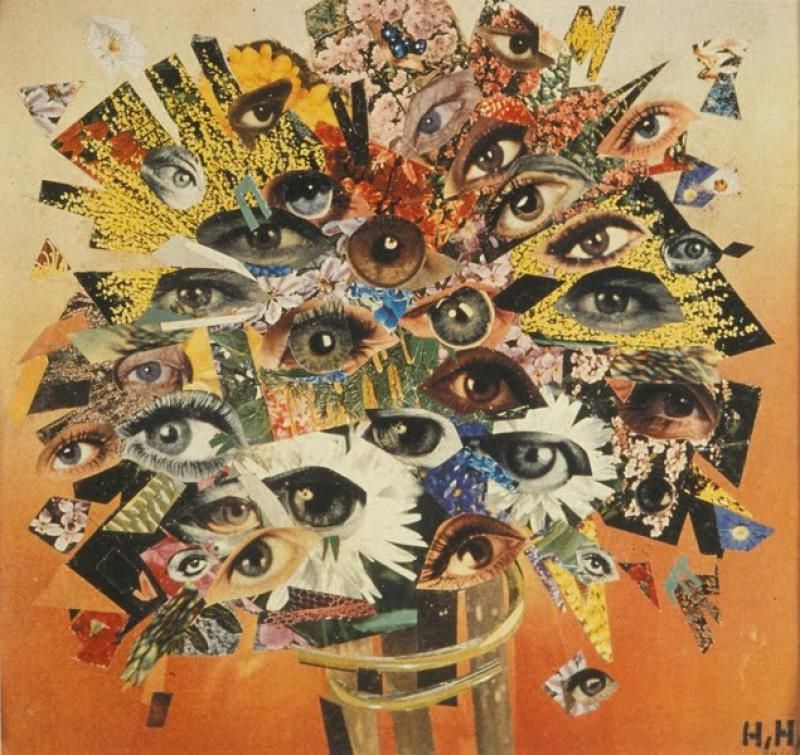
Photo-montage was also used by various pop-artists in the mid 20th century. Pop Art was a reaction to abstract expressionism and was similar to Dada in some ways.
Abstract expressionism is the term applied to new forms of abstract art developed by American painters such as Jackson Pollock, Mark Rothko and Willem de Kooning in the 1940s and 1950s.
Many Pop Art images and constructions tackled popular consumerism, advertising, branding and marketing techniques. Pop art also explored political concerns such as gender roles and war.


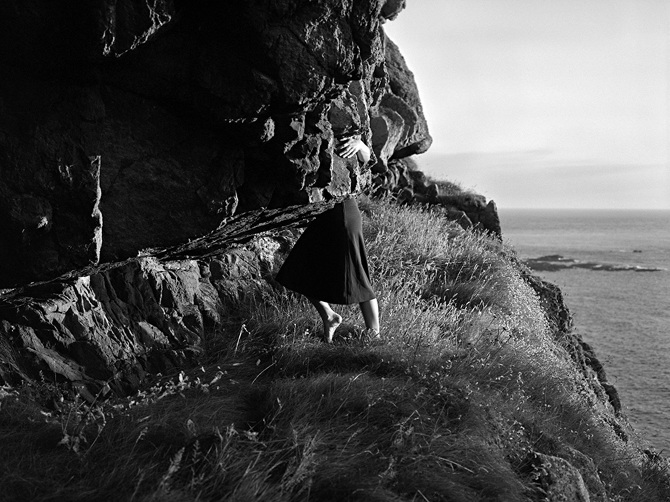
The exhibition at the CCA gallery has a purpose to show the response Clare Rae has made to the photographer Claude Cahun through her work. The exhibition does this successfully by separating the two artists work into adjacent rooms, even though kept apart both artists work are hung in the same way, both display the work without boarders to the photographs and each piece of work spaced differently and this was effective for the type of exhibition. The exhibition was successful in that Clare Rae had successfully responded to the work of Claude Cahun in matters of her style of work and the final finish of the work
The exhibition was successful in that Clare Rae had successfully responded to the work of Claude Cahun in matters of her style of work and the final finish of the works.
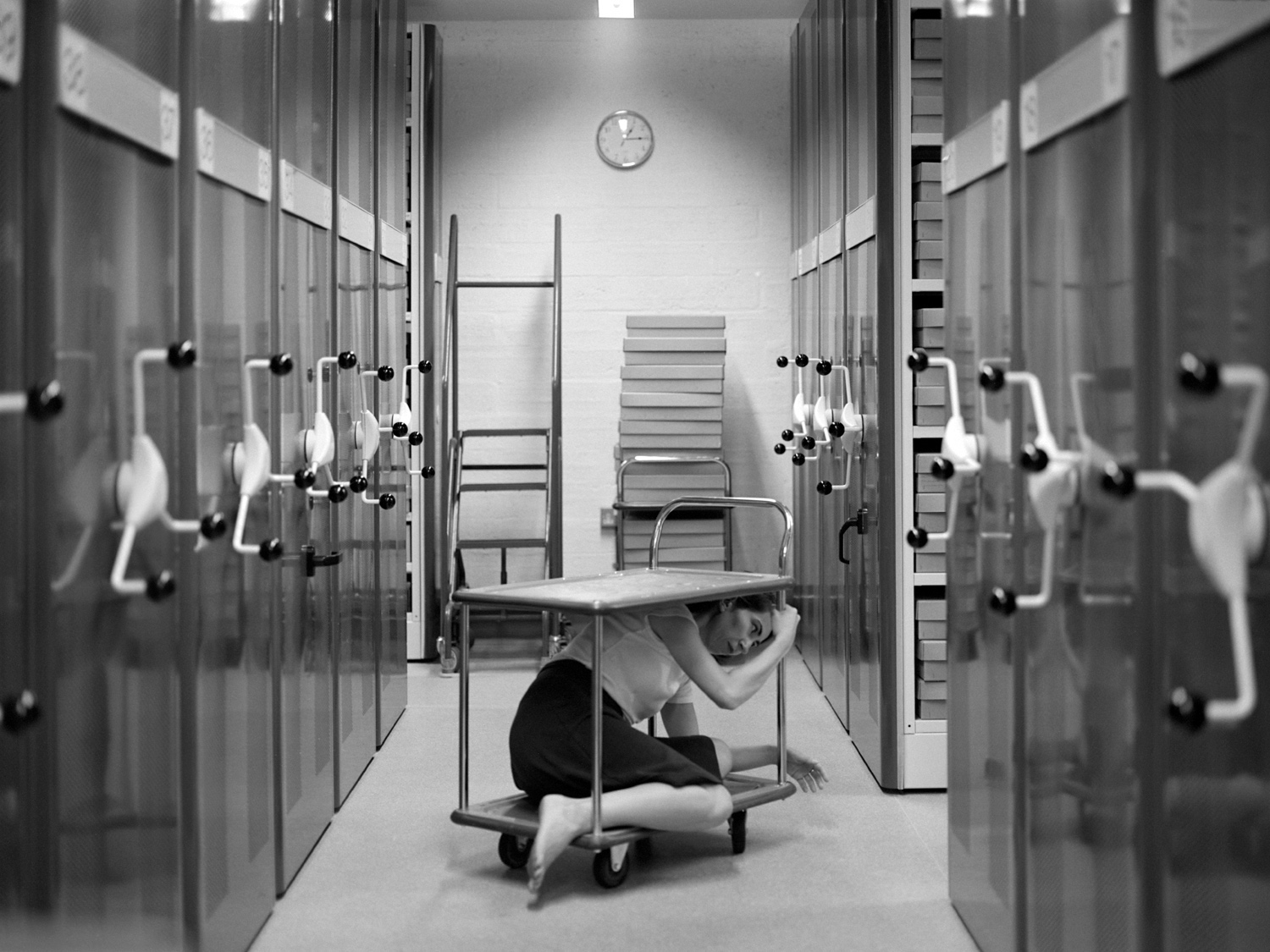
This is one of the photographs produced by Clare Rae in response to Claude Cahun. From looking at the photograph I can understand and visually see where her influence has derived from. Her use of space shows a direct link towards one of Claude Cahuns own photographs. The photograph creates and effect and impression of the depth and use of the space around her as she crams herself under the top of the trolley. This is a similar idea that Cahun previously looked into as she placed herself into the self of a cupboard.

Above shows the photograph first created by Claude Cahun and it is the photograph that I believe has been the one to influence Clare Rae to produce the photograph she created above. I feel Clare Rae successfully responded to Cahun through her work as she has looked into the different elements Cahun used in her work and for this particular response it was her use of space and how she places her body into the unusual spaces.
I believe Clare Rae has been heavily influenced specifically in this project of her work by Claude Cahun and I also believe that she has successfully reproduced her own work in response by experimenting with how she places her body into the landscapes and into the spaces.
WHO – this is a recreation of Arnis Balčus’ work, using my own model in order to take form of the little boy
WHAT – the main objective of this photo shoot is to recreate and understand how Balčus creates his work and the symbolism which he chooses to include and adapting the environment and resources I have in order to recreate the photo in a similar way.
WHEN – the image was taken during mid day as I figured this would be a similar time of day judging by the original image and the direct sunlight in it
WHERE -the image was taken in an old communal garage space which resembles the location a lot in the image I am trying to recreate.
WHY – to understand the most suitable ways in which to photograph people, organize photo-shoots and comprehend the symbolism which has been used by the original artist
HOW – I used my regular DSLR camera for this photo shoot, all natural lighting.
FINAL IMAGE –
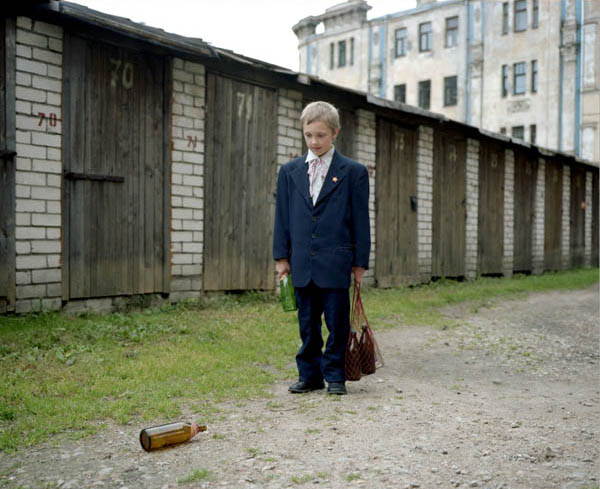
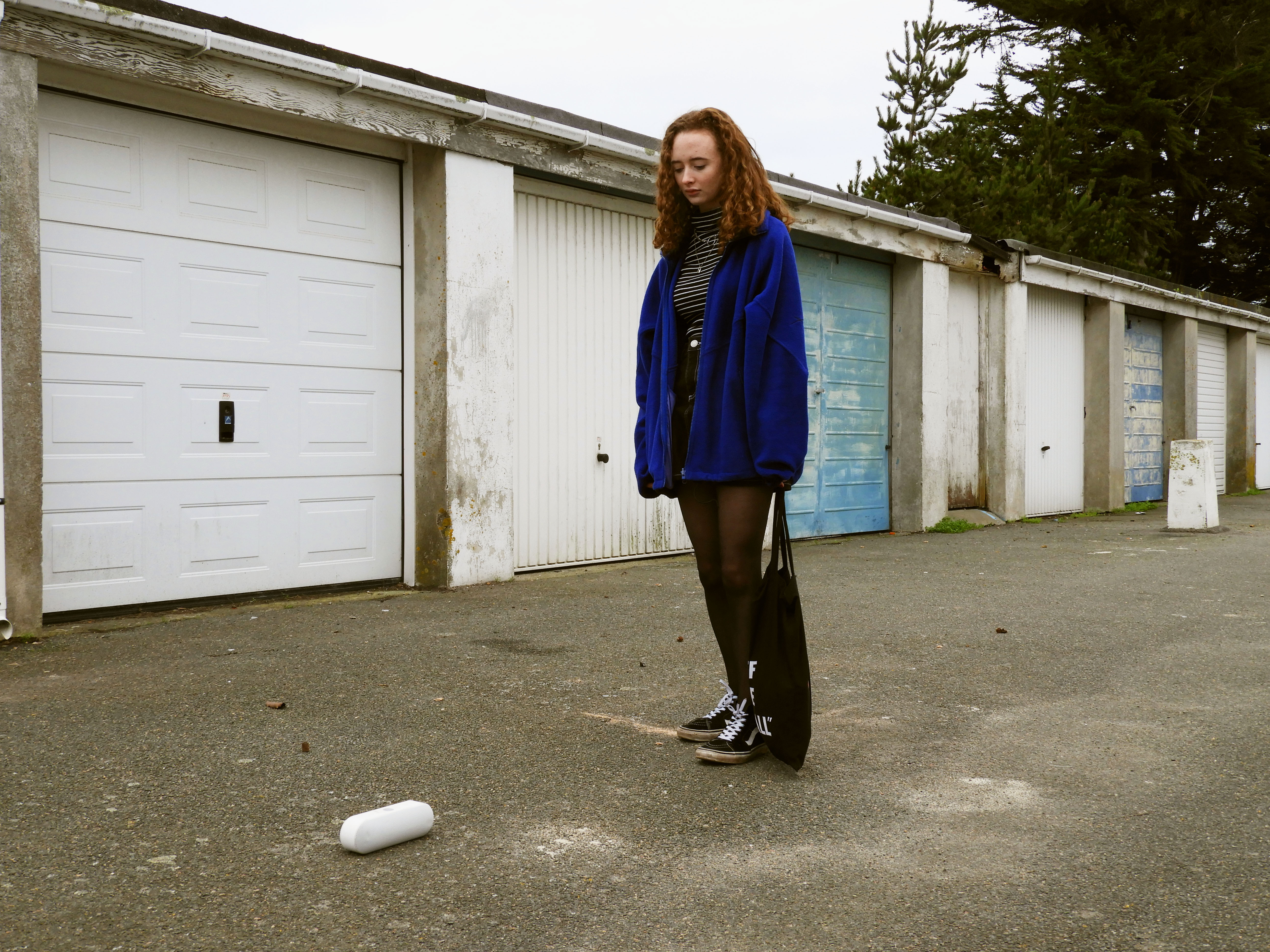
VISUAL ANALYSIS OF IMAGES –
VISUAL –
The image overall has a very gloomy and depressing mood around it. The depiction of a small child (recreated by a model which is also quite child like), looking at the empty beer bottle is synonymous with the prevailing alcohol abuse problem in Eastern Europe. The environment, which is worn and old, also suggests poverty and shortage of necessities for the child, almost using the beer bottles as toys. The child portrays sadness and loneliness. To put a modern twist on my own imagery, the glass bottle has been replaced with a speaker, as this is representative of the technology reliant youth of today. The weathered and old garages in the back of the image nicely contrast the main subject in the foreground by disturbing the repeating pattern. In order to have some similarities with the original image, the model is wearing a bright blue jacket, which immediately draws in the viewers eye to the center of the image. Both images can be split up with the rule of thirds, where the subject is situated in the middle of the image. The upwards facing power play between the camera and the model makes her seem a lot taller than reality, giving some power to the subject. The neutral expression of the model also creates a theme of confusion and mystery in the image as the viewer is not clear on what the subject is feeling. The direction in which the subject is looking at, leads also the viewers eyes down to the ground where the speaker is (situated in the bottom left third of the image). The overall color scheme of the image is dull and neutral, being mostly made up of subtle blues and grays.
TECHNICAL –
This photo was taken during late morning, on a cloudy overcast day. I especially chose this day due to the fact that this is what resembled most in the photo I was trying to recreate. I set the white balance of my camera to the “cloudy” setting in order to achieve well balanced images. As it was a cloudy, yet still bright day, I turned down the ISO of my camera down to 200 to avoid the image being overexposed. As this was a very staged image, and the subject was standing still, I chose to use a tripod to make sure the image is crisp without any motion blur, due to this I kept my aperture mid way at 1/125 as I wasn’t concerned with the camera moving. I had a very clear idea of the positioning of the model and the prop therefore I first angled my camera and refereed to the original image for guidance. After a couple of shots, I was confident in the final image therefore contact sheets for this photo shoot weren’t necessary.
CONCEPTUAL –
The main objective of this photo shoot was to make sure that what I was recreating conveyed similar visual elements as the original image, using a model of a small stature and an environment which is very similar as the original. Of course as I am not the original photographer, not in the same environment, I have had to adapt and make do with the resources I have resulting in the differences seen in the image. I wanted to convey a different social issue which affects us here in Jersey, relating to our environment and society, with the presence of the speaker on the ground. Representing how technology dependent the youth is, looking to it for guidance, happiness and companionship. This effecting social skills and the way in which children grow up and interact with one another.
CONTEXTUAL –
At the end of the 1980s all the countries of eastern Europe and the former Soviet Union enjoyed relatively high levels of human development and social welfare. Extensive social investments during the period of communist rule meant that literacy was almost universal, and well above other countries with comparable levels of per capita income, and life expectancy averaged 68 years. Unemployment was unheard of and – at least officially –poverty did not exist. Few commentators could have foreseen that the process of transition towards market economies and democratic governments would have been so tumultuous and accompanied by such high costs in terms of individual well-being, particularly among the countries of the new Commonwealth of Independent States (CIS). The collapse of economic output in many of these countries following independence, along with hyperinflation that wiped out individual savings, resulted in a dramatic drop in living standards for the majority of people and the emergence of poverty as a major issue within the region. Increasing poverty leading people to alcoholism and the use of it in daily life.
Nearly all the top 15 biggest drinking nations are in Central or Eastern Europe. Poverty and the harsh climate, particularly in Russia, play a part, as does the tradition of drinking. “Where it’s extremely cold it’s not uncommon for people to drink all day long,” said Val Smith, president of International Wine and Spirits, which provided the data on per-capita alcohol consumption.
And particularly in agrarian regions; farmers often produce their own home brews from anything ranging from potatoes to sugar beets, making alcohol very accessible and very cheap, said Smith. This also makes per capita consumption hard to measure, with official figures sometimes well below actual consumption rates.
source: https://www.unece.org/fileadmin/DAM/ead/pub/041/041c7.pdf
To produce tableau vivant images, the studio was used in order retain full control over things such as lighting and the background. The images that we decided to replicate were the following:
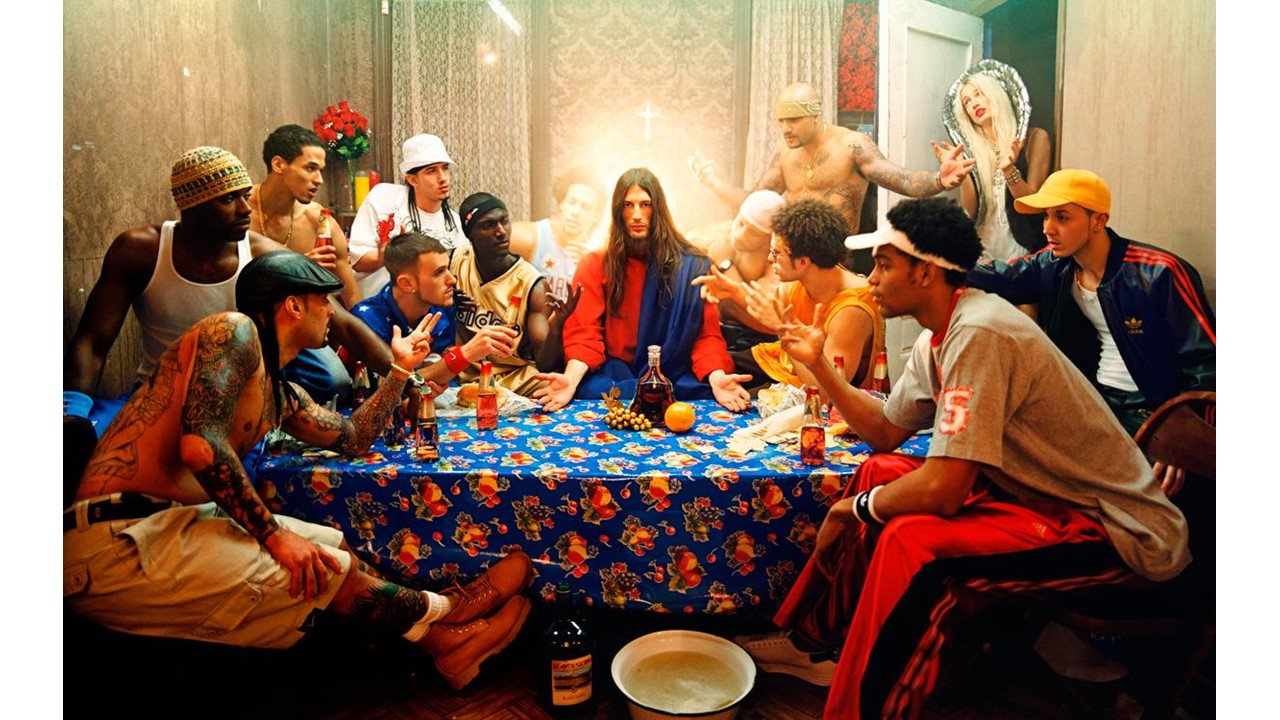
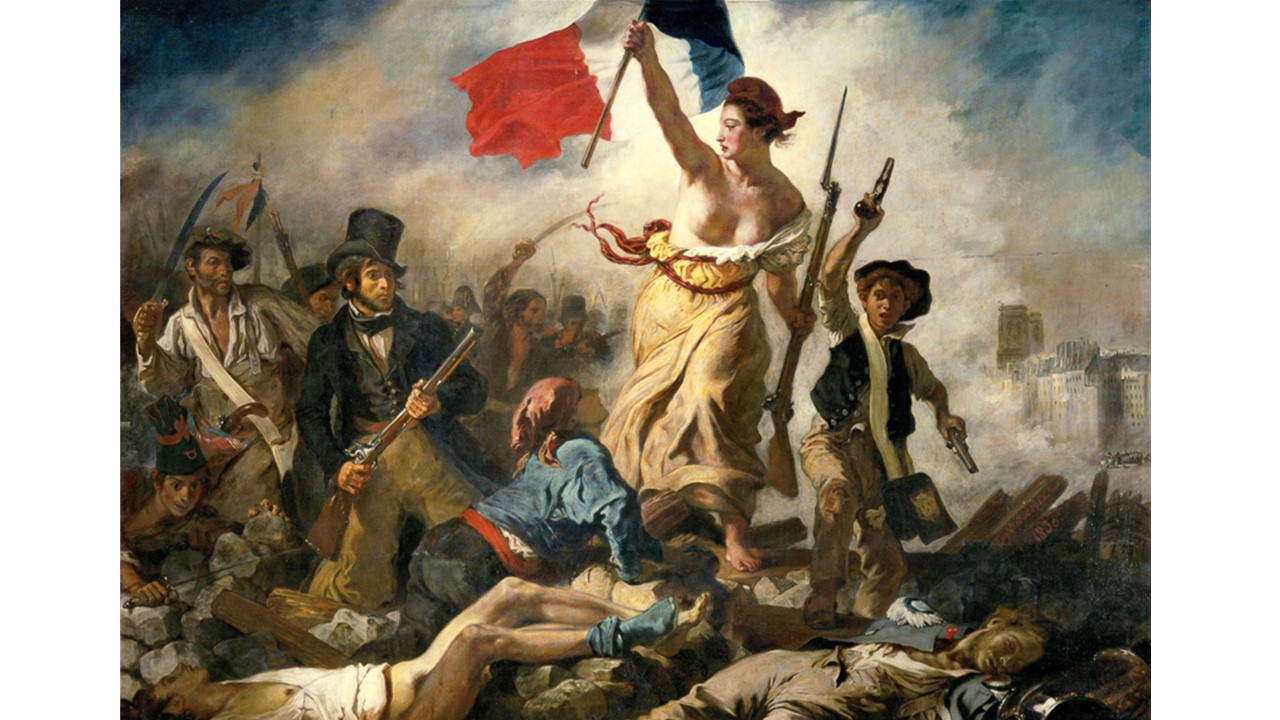
All of the above images were chosen for their story telling visuals, as each image portrays a still frame from what would usually be depicted as a fast moving scene.
The products of the photo-shoot we conducted in the studio can be seen in the contact sheets below:
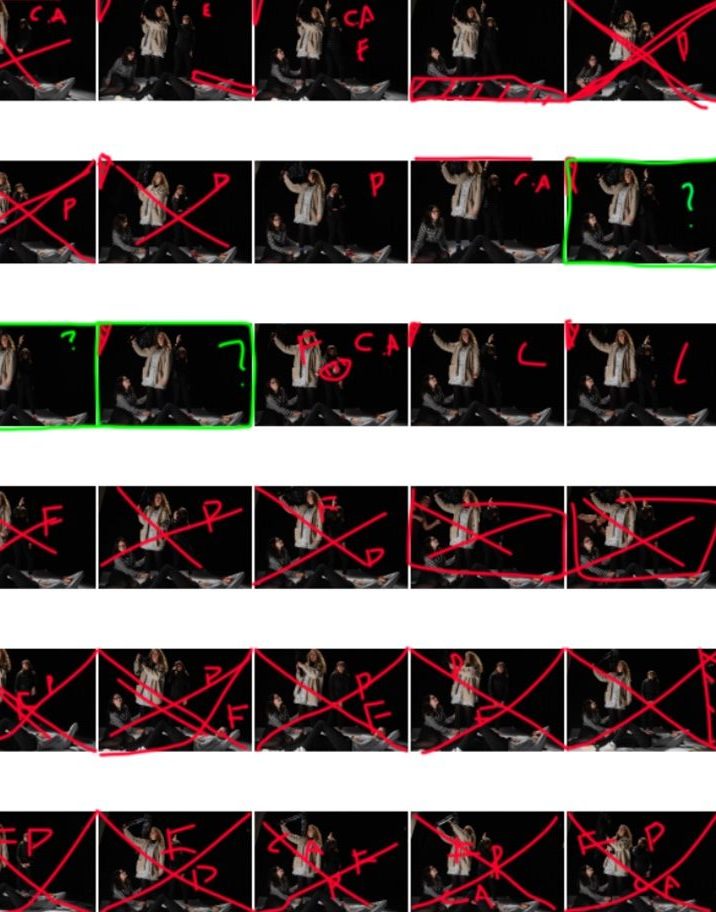
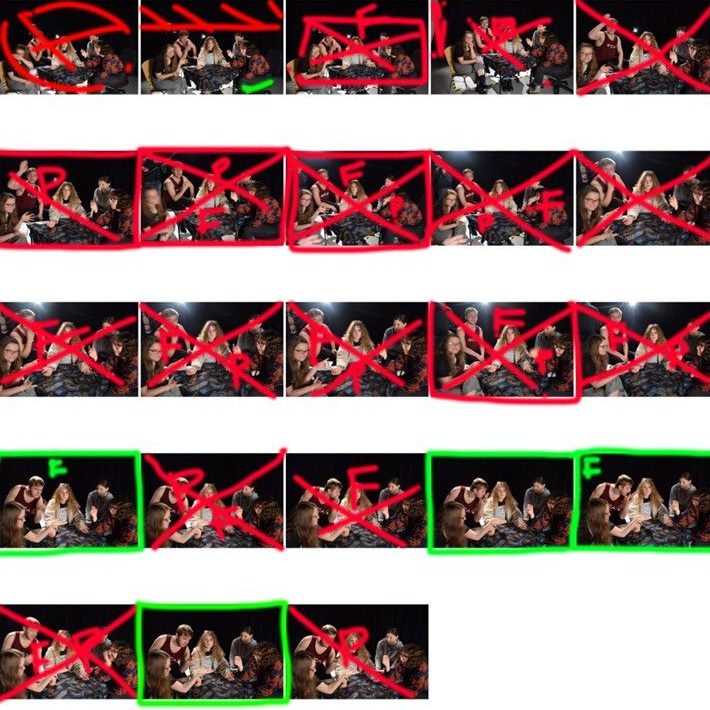
Key:
Red F: Out of focus, Red P: Subject in the wrong position, Green F: slightly out of focus, Green P: subject in slightly incorrect position, Red box: discarded image, Green box: selected for possible to final image
The above images were taken by a range of other students within the photography class, and the lighting and prop management was coordinated by a range of photography students as well. After analyzing the end results for the tableaux photo-shoots, I have decided on the following 2 final images:
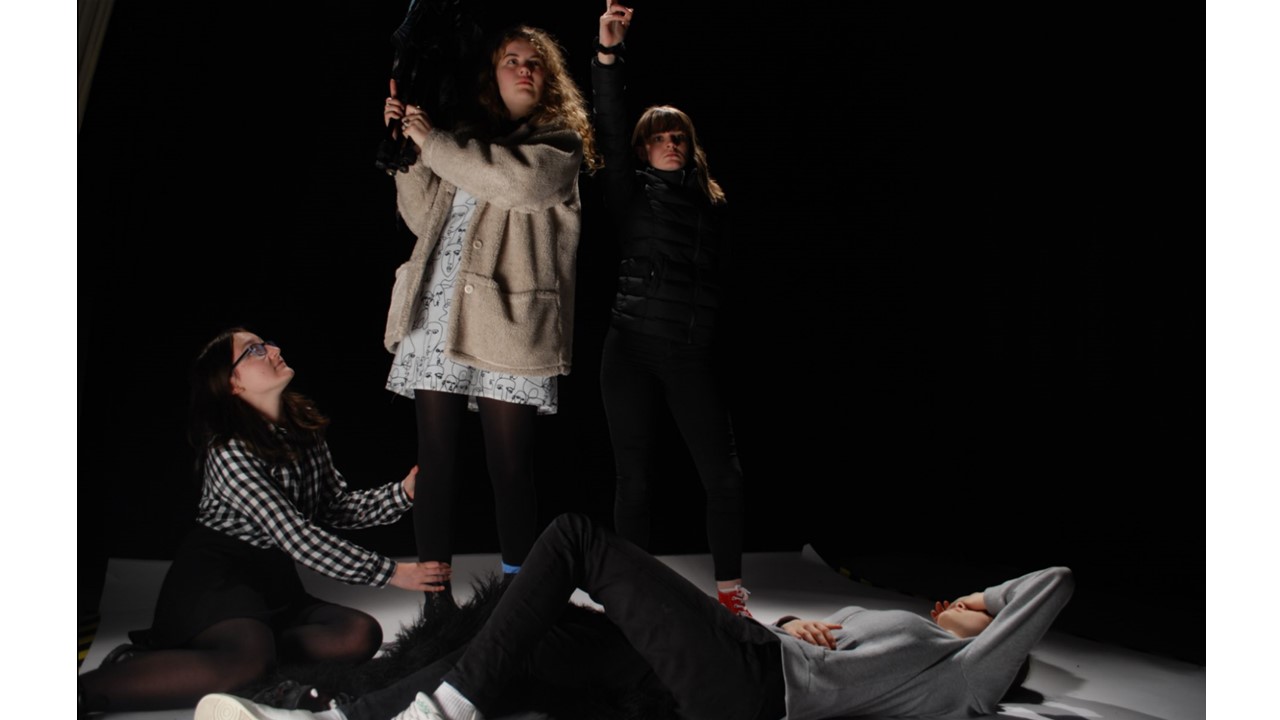

Above is the final edited image from the photo-shoot in which we attempted to recreate “Liberty Leading the People”, a painting created by Delacroix. This image required props in order to create a flag, and the studio was used in order to draw maximum attention to the subjects in the foreground. The lighting in this image is focused on the subject representing Liberty, and the rest of the image is relatively shaded. This is done to mimic the atmosphere of a war setting, and the saturation as been turned up slightly to mimic the slightly orange tone of the original image. The image has also been edited to remove the white floor and curtains in the background, allowing or the image seem slightly more realistic


The image above is the final edited image from our attempt to mimic the photograph taken by Lachapelle, “Last Supper”. For this image we used a table as a prop, and pointed the lighting towards the subject in the middle of the table, accentuating the fact that this subject is supposed to represent Jesus. Editing has resulted in the darkening of the background, which allows for the scene to draw maximum attention to the subjects and the foreground.
Photo montage is the process of putting together multiple picture in order to create a new image with a different feel. This is done by gutting, gluing and rearranging two or more photographs to make a new one. There is also a more popular method of creating the idea of photo montage which is done on an app called ‘ photoshop’.
Photo montage became a thing is the 1880s and was first done by merging different photos together into a combination print. It was then again looked at in the 20th century by Dadaist and Futurist artists.
The most iconic photo- montages were produced by George Grosz, Hannah Hoch and John Heart.
What photo montage is used for
Photo montage can be used for protesting subjects, political purposes ie, World Wars, and for conveying opinions. When creating the photo montage it can be done though hand manipulation ( cut and stick) as well as Photoshop.
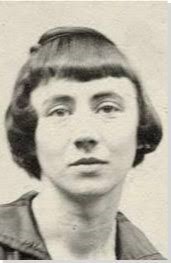
Hoch was born in 1990 on November 1st in Germany. She began her training in 1912 at the school of Applied Arts in Berlin- Charlottenburg. However, after being there a few years she ended up moving back to Germany after World War 1 started in 1915. While being away she changed to specializing in glass design but went back to focusing on painting, graphic design, wood cut and linoleum- block- painting until 1920.
Hock first became interested in photo montages properly in 1917 and herself and Dadaists were the first to fully explore the idea of photo montages. She continued to make art through WW1 and tried to stay relevant after it ended which proved to be very hard.As she grew and developed she worked with new modes of expression but continued to reference her past. Hoch was such a key part of photo montage and was clearly an important influence during her period of six decades of hard work. Her work began to receive more attention in the late 1960s which was due to the concerted effort by feminist scholars and artists to uncover and reclaim the art created by her in the 20th century. She died on May 31st in 1978.
Pieces she produced..
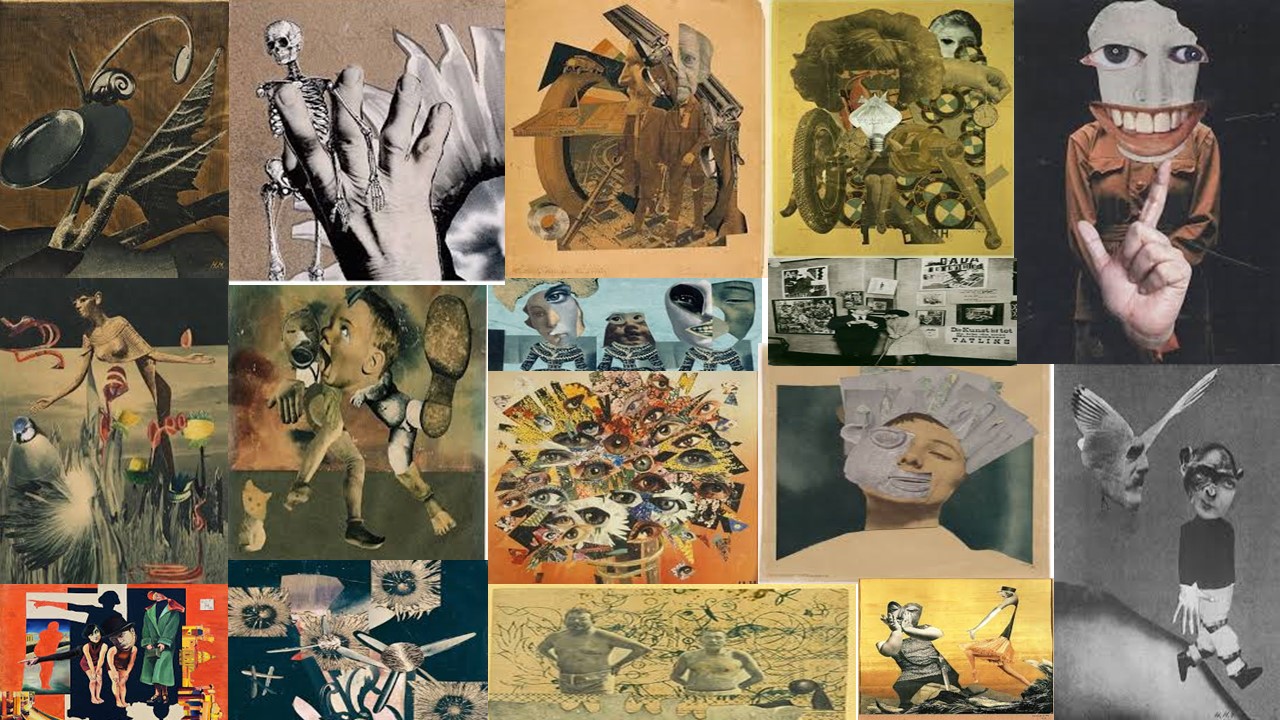
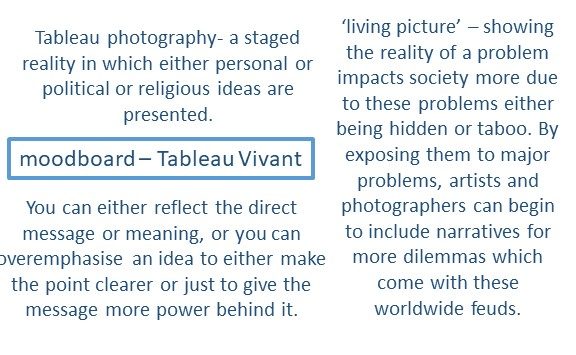
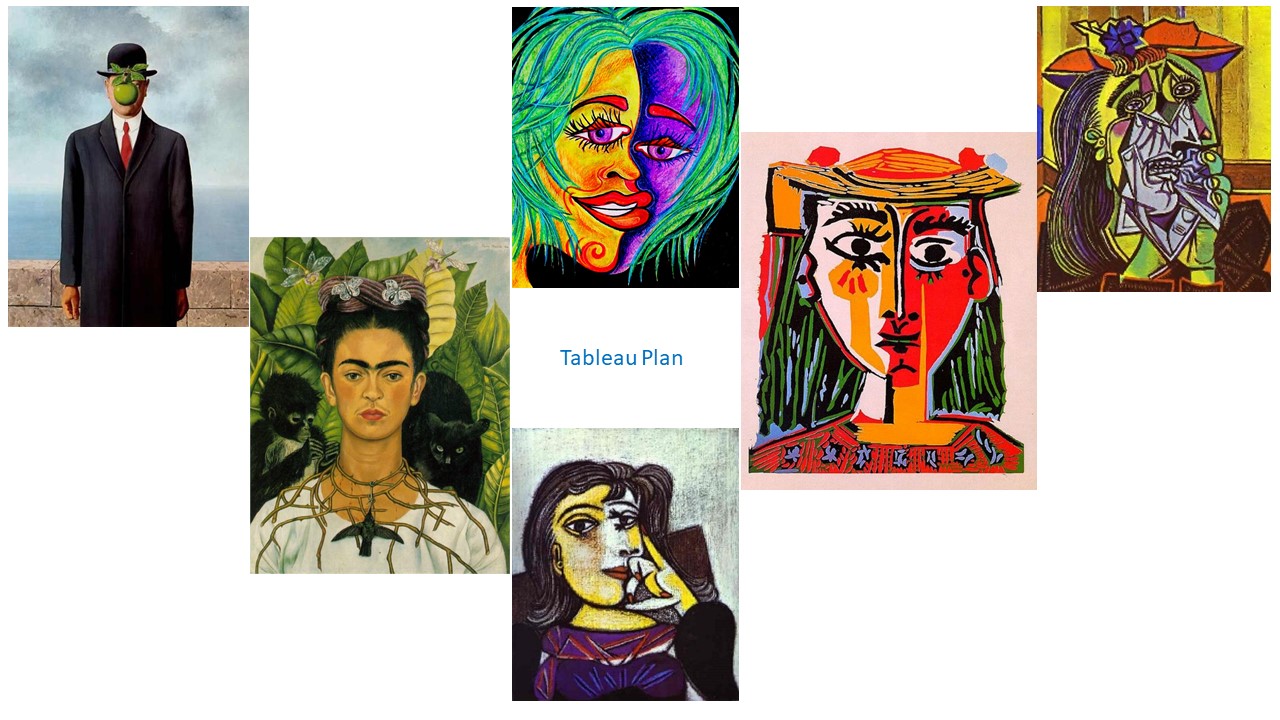
My idea is to replicate abstract portrait paintings. These paintings all reflect someones individual identity and how they think they are perceived in the world. For example, Frida Kahlo’s work is all about her empowerment because when creating her work, women were seen as the weaker gender in society. Kahlo’s paintings often feature root imagery with roots growing out of her body to tie her to the ground, reflecting in a positive sense the theme of personal growth; in a negative sense of being trapped in a particular place, time and situation; and finally in an ambiguous sense of how memories of the past influence the present for either good and/or ill. In ‘My Grandparents and I’, Kahlo painted herself as a ten-year holding a ribbon that grows from an ancient tree that bears the portraits of her grandparents and other ancestors while her left foot is a tree trunk growing out of the ground, reflecting Kahlo’s view of humanity’s unity with the earth and her own sense of unity with Mexico.
These portraits were all a key turning point within the world or artistic culture: with Picasso who covered a range of topics from isolation to family. These artists opened the worlds eyes to abstract art which is understandable. They portrayed ideas in such augmented realities that they made sense.
My plan
My photo shoot plan fro Tableau photography is to replicate these paintings on peoples faces so that I can reflect the physicality and emotions behind these abstract portraits.
Frida Kahlo is going to be my main influence due to her views are so strong in her time in society. I would recreate scenes from the biopic movie ‘Frida’ give a sense of what her life was outside of her controversial paintings.
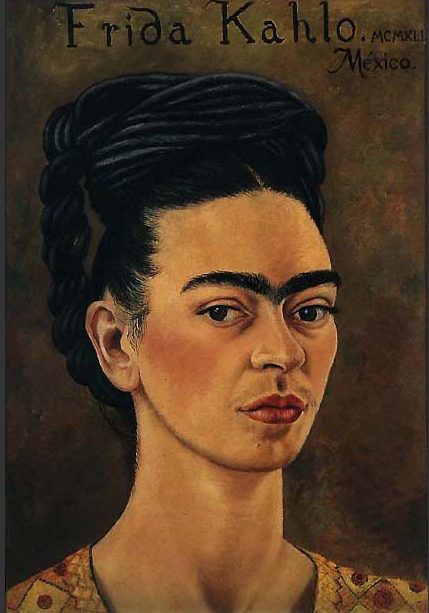
What is photo-montage?
Photo-montage is the putting together of multiple pictures in order to create a new image with a completely different feel to what the separate individual images would have created. This is done by cutting, gluing, rearranging and overlapping two or more photographs/images to make it entirely new one. sometimes this can cause the image to look some what like a photogenic print. Now days there is a more popular method of creating the idea of a photo montage and that by using a new application called ‘Photoshop’ do help ‘cut’ and edit the picture together this is known as ‘composting’ and is a more modern term for photo-montage. Although photographers need to be aware that a composite of related photographs to present a scene with all related images or subject is not considered a photo-montage.
What the history behind photo-montage?
In the 1880s was where first merging different photos together became about which was then called ‘combination print” and was most popular in a form of the contrived group portrait. The subjective and bizarre juxtaposition were further looked into by Dadaist and Futurist artists of the early 20th century. Some of the most iconic photo-montages were produced by George Grosz, Hannah Hoch and John Heart field from the being stages of photo-montages being produced. This also came extremely popular and was used extensively during the Pop art movement of the 1960s and 1970s. leading to more technical forms being produced by photographers like Jerry Uelsmann and David Hockney .
Dadaist=
Futurist=

Hannah Hoch
Hannah Hoch born in 1889 on November 1st in Gotha, Germany. Hoch began her training 1912 at the School of Applied Arts in Berlin- Charlottenburg. Here she concentrated on glass design with Harold Bengen, soon to be cut short when the break out of World War 1 began. However returned back to Berlin and began back at Applied Arts in 1915, although changed her specializing in glass design and moved her focus to painting, graphic design, woodcut and linoleum-block-painting with Emil Orlik until 1920. In 1915 she met and became romantically involved with Australian artist Raoul Hausmann, who in 1918 introduced Hoch to Berlin Dad circle, a group of people including George Grosz, Wieland Herzfele and Wieldlands brother John Heartfield. This then lead her to experiment with nonobjective art though painting but also looked into the idea of collage and photo montages. in 1917 is Hosh’s true interest in photo montages properly began. Hoch and Dadaists were the first to fully explore the idea of photo montages. Then in 1934 Hoch was names as a ‘cultural Bolshevist” by the Nazi.In order to continue to make art during World War l she retreated to a cottage in Heiligensee, on the outskirts of Berlin. After World War l Hoch tried extremely hard to stay relevant to the time period and continued to show of her hard work by putting them in exhibits through 1945 and 1946. As she grew and devleloped she worked with new modes of expression but continued to reference her past. Hoch was such a key part of photo montage and was clearly an important influencer during her period of six decades of hard work. Her legacy will obviously continue with her strong contribution to the Dada movement. In the late 1960 and 70s her work began to receive more attention due to the concerted effort by feminist scholars and artists to uncover and reclaim the art created by Hich and other during that particular time period of the 20th century. Hannah Hoch tragically passed away on May 31st in 1978 in West Berlin.
Some of her pieces she produced:

